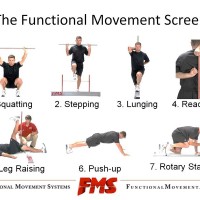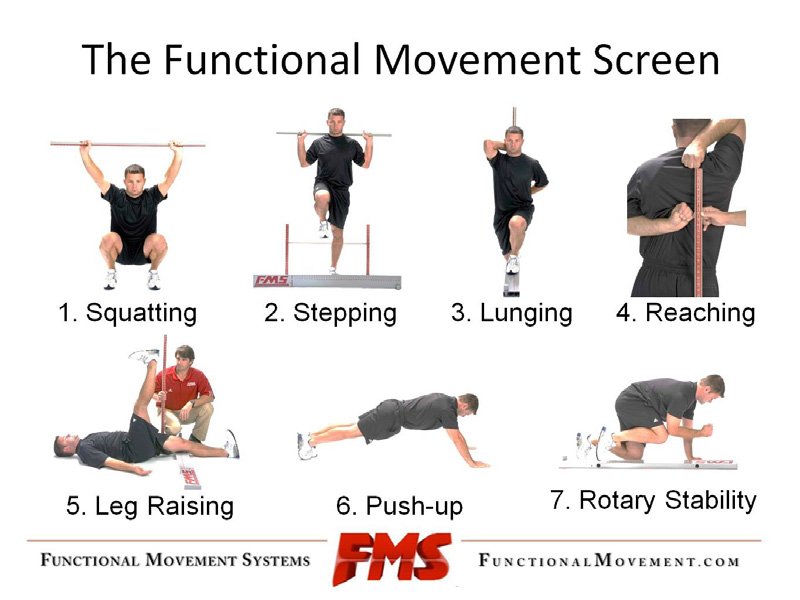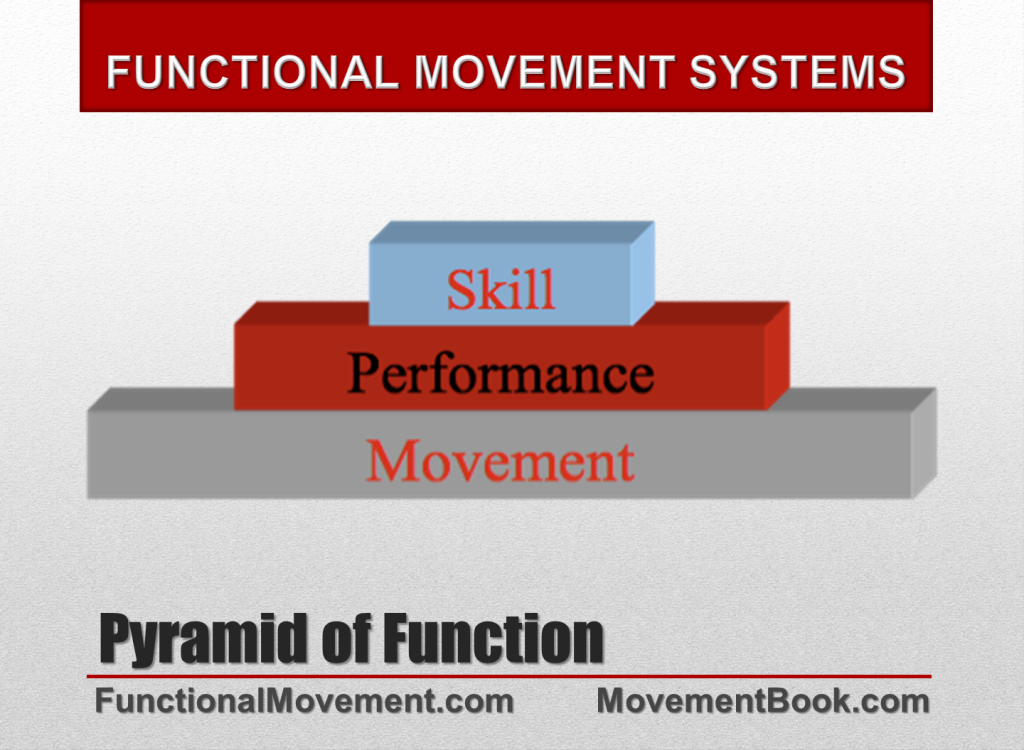
 Functional Movement Systems Seminar
Functional Movement Systems Seminar
What is a Functional Movement Screen?
This past weekend I attended the Functional Movement Systems Level 1 and Level 2 seminars, the following are my main take-aways.
The Functional Movement Screen
The Functional Movement Screen is a standard operating procedure for assessing functional movement, providing a baseline for movement competency. The 10-15 minute screen scores seven patterns with the intention of identifying dysfunctional movement and asymmetries. The objective screen provides a framework for corrective exercises, which then can be evaluated in their effectiveness of improving movement patterns.
Movement competency lays the foundation for strength capacity and skill development. Gray Cook emphases the point that athletes should not add strength to dysfunction. The FMS determines whether or not an athlete can ‘access’ a certain movement pattern.
The performance pyramid’s foundation is functional movement on which functional performance and functional skill rests.
Four Primary Objectives
A: Philosophy of the Functional Movement Screen
Screening movement allows for a qualitative metric for determining movement competency. Fitness training measures quantitative metrics like strength, power, speed, and endurance whereas a qualitative metric looks at how well an athlete can perform developmental movement patterns like squatting, lunging, stepping, reaching, leg raising, and rolling/crawling (ipsilateral/contralateral movement).
B: The Functional Movement Screen
All of the seven movement patterns require a balance between mobility and stability. Motor control is having all the right components of a movement at the right time. It answers the question of how well you can create movement into your extremities while stabilizing the core.
“Mobility is addressed first because adequate stability cannot be present with reduced mobility. After mobility is improved static and dynamic stability are trained – If you just stretch you will have naïve range of motion.”
Mobility: Active Straight Leg Raise, Shoulder Mobility
Motor Control: Rotary Stability, Trunk Stability Push-Up
Functional Patterning: Inline Lunge, Hurdle Step, Deep Squat
#1: Active Straight Leg Raise
It was highly stressed that the ASLR is not a hamstring test – there are a lot of factors that determine an athlete’s ability to disassociate hip flexion of one leg from hip extension of the other leg. The ASLR determines an athlete’s readiness to hip hinge (deadlift), run, lunge, and reflectively stabilize the core during leg movement.
The Straight Leg Raise is the Highest Priority of the Functional Movement Screen and is targeted first if dysfunctional or asymmetrical.
#2: Shoulder Mobility
A key point for shoulder mobility was to address thoracic rotation when a shoulder asymmetry is noted. Aim to improve thoracic rotation, then thoracic extension. Shoulder mobility is dependent on good thoracic and cervical spine motion and reflective stabilization from the diaphragm. Two things the shoulder loves are compression and distraction – the kettlebell can be used for each (turkish getup, suitcase carry).
#3: Rotary Stability
The essence of the rotary stability test is being able to maintain a neutral spine during arm and leg movement. The rotary stability test screens both ipsilateral and contralateral arm and leg movement that comprise rolling (throwing) and crawling patterns (walking/running).
#4: Trunk Stability Push-Up
The foundation for the pushup is the plank. The pushup is not a shoulder exercise it is a core stability exercise. The plank is extremely effective at improving bad posture (upper crossed syndrome). A common compensation during the pushup is rotation (twisting on the way up), which indicates poor rotary stability (anti-rotation). In this case the prime movers are incorrectly engaging before the stabilizers.
#5: Inline Lunge
The inline lunge is a representation of good deceleration, whereas the hurdle step represents the capacity for acceleration. Ankle mobility comes into play with the inline lunge, hurdle step, and deep squat.
#6: Hurdle Step
The hurdle step is a good example of the layering of the movement patterns – requiring a good active straight leg raise, rotary stability, and trunk stability. Hip and ankle mobility are also required while balancing on one leg during the stepping pattern.
#7: Deep Squat
If an athlete does not have good ankle mobility, trunk stability, and hip/shoulder mobility they will not be able to be able to squat well. Improving the straight leg raise or rotary stability strengthens the squat pattern. Gray Cook has said, “Maintain the squat – train the deadlift” – which goes back to the straight leg raise as the foundation for both bilateral and unilateral movement.
“We used to first go after the deep squat – we now go after the six patterns underneath it.”
C: Scoring/ Interpreting Results
The scoring for the screen is a 3, 2, 1, or 0 on each exercise. Three is perfect form, two is completion of the screen with dysfunction, one is a failure to complete the screen, and zero indicates pain – whether or not an athlete completes the exercise.
3: Perfect
2: Cool
1: Not Cool
0: Pain
The screen is completely objective – scoring is done during the screen – without interpreting the results till afterwards. Scores of zero (pain) should be evaluated by a medical professional. What matters is not the total score – but identifying dysfunctional movements (1’s) and asymmetries.
“Asymmetries always take priority since they create the highest risk for injury.”
D: Correctives
Conditioning is adaptations in structural integrity or performance overtime. Correctives are immediate positive responses in movement to corrective exercises. A single leg deadlift can be used as a conditioning tool or corrective exercise. The difference is how and why the exercise is used. A corrective exercise addresses a dysfunction of a specific individual.
The essentials of corrective exercise were covered in depth – breathing, the chop and lift, deadlifting, and rolling. Deadlifting is not about chalk, blood, and sweat – it’s about learning to hinge through your hips for daily activities.
Coaches should integrate correctives into workouts – an athlete with a shoulder mobility restriction can do a rib roll to improve thoracic rotation between sets of goblet squats.
FMS Training Cycle
The FMS training cycle is based on identifying the corrective pattern, mobility competency, static motor control, dynamic motor control, then and performance.
The art of correctives is taking an athlete to the edge of their ability. Giving an athlete with dynamic proficiency static drills is like taking someone who is in advanced algebra and putting them into basic math. On the other hand, it is important to recognize when an athlete is using a high threshold strategy for a low level task.
One of the most useful concepts of the FMS corrective philosophy is, “Sometimes what we remove is more important than what we add.”
Dysfunctional movement or asymmetry during a movement pattern like the active straight leg raise provides a template for what related exercises should be avoided until correctives are applied to the movement pattern that supports that exercise.
Red Light, Yellow Light, Green Light
If an active straight leg raise is dysfunctional or asymmetrical there are exercises that can be categorized under red light, yellow light, or green light (avoid, use with caution, train).
Hip hinging should be avoided (deadlift, kettlebell swing). Step-ups, squats, and split-squats should be carefully observed during training. Upper body training, core work, and half-kneeling exercises are all green light and potentially useful for correcting the dysfunctional pattern.
I highly recommend that coaches and athletes go through a Functional Movement Screen and integrate some of the key concepts into their current training philosophy.
– Kevin Kula, “The Flexibility Coach” – Creator of FlexibilityRx™ – www.FlexibilityRx.com
Related Resources
Functional Movement Systems (link)
Pre-Hab and the 80/20 Functional Movement Screen (link)
Tags: FMS, Functional Movement Screen, Functional Movement Systems, Gray Cook, mobility, motor control, performance pyramid, stability

Leave A Reply (No comments so far)
You must be logged in to post a comment.
No comments yet